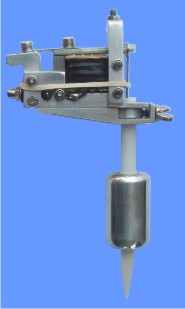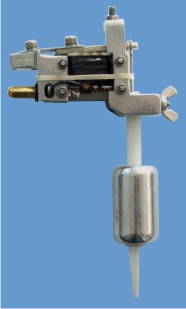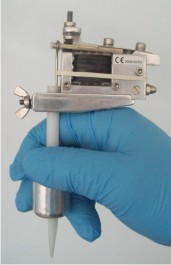



Copyright © 2019 Mystic Art Productions Limited E-Mail: mystic@mystic.co.nz
My
Best Pictures
Best Pictures







Double click to edit


The Pulse machine has developed a cult following around the world since the first model went on the market in 1989.
When I first started building Tattoo machines back in the late '70's I started with rotaries as they were the easiest to make. I found that they held me back and because of their even power band they did not have much of a punch. Fine for the smaller clusters like 3's and 5's but not so good once you wanted to work with bigger clusters which would tend to bounce off the skin rather then punch through so I needed to hold the skin excessively tight and they were still not so nice to work with.
I then progressed on to building D.C. machines and found these to be much better for me.
But there still seemed to be something not quite right about them and they too slowed me down. As an artist I wanted machines that I could tattoo with at a speed that suited me rather then have my creativity stifled because I was being held back by equipment. It's important to note here that it's not the speed that a tattoo machine runs at that allows you to work fast but how the tattoo machine "hits", I didn't understand this until I made my very first pulse-matic.
So here is my take on how all the various machines available around the world "hit", I believe you can assign all machines into one of three catorgeries. It's very important to realise that regardless of the type of machine an artist uses, techniques have been developed for all types, which when used correctly will allow someone with good skills to make beautiful tattoo art regardless of machine and at the end of the day if you are comfortable using rotaries, pneumatic machines or D. C. coils and you are happy with the results then that is all that counts.
1-ROTARIES. Because they are motor driven they generally have a very even power band, by that I mean that the power behind the needles when the cluster is half way down it's stroke and just before it bottoms out is constant, it does not get stronger or weaker as it travels through it's downward stroke. Because of this I find they lack penetration with larger clusters. A good rotary with small clusters will, in my opinion, cause less trauma then a DC machine when used correctly because they have very little give at the bottom of the stroke. If you set the needle depth at the tip then that's pretty much how much needle will go in the skin if the skin is stretched real tight to compensate for the lack of punch.
2-D.C. COILS. The most popular machine out their. Prior to making the Pulse machine I used D.C. machines for over a decade and many great artists use D.C. which also leads to D.C. machines being popular as many try to emulate the top artists. With the right set-up with springs, coils, A-bars etc. you can get a D.C. machine to run fast or slow, hard or soft. The power band of the D.C. machine is very different to the rotary, the downwards stroke of the needles start from zero and builds in speed and power as it progresses towards the end of the stroke, but before the needles reach the end of the stroke the power turns off at the coil so the needles rapidly lose speed and force right towards the end of the stroke. This is their one major flaw! and every D.C. machine ever made, regardless as to whether it's a shader or liner, lacks power on at the bottom end of the stroke.
This means that if you set the needle depth at the tip, that's not generally what will go into the skin first hit. Because the points on the D.C. machine separate before the A-bar is hitting the top of the coils the power is off before the the needles are at the bottom of the stroke. The tensile strength in the clients skin will decide to a degree how far the needles actually go in. Ever wondered if using D.C. why the machine changes how it sounds and can sound very mellow when working on different parts of the body, this is why.
So every D.C. machine has this flaw but like all flaws, people will usually work out ways to mitigate them and that's exactly the case with D.C. machines, the layering technique comes to mind. When using D.C. the needles only penetrate a little into the skin with each hit, it can take several hits in the same place to get the ink down to the depth required, with the needles getting progressivly deeper with every pass. This is why many D.C. machines are set up to run at fast speeds like 120/150 Hz for lining, but when you watch many artists lining with D.C. the hand speed is quite slow.
Try and get your head around this as an example. Machine speed is 130Hz, that's the needles hitting the skin at 130 times per second, say you have a 3 needle liner with .35 (#12's) needles, one hit with the needles leaves a footprint (small dot) .70 mills in diameter, say you need to move the needles along by 1/4 of the diameter to lay the next dot of colour so as to have an even edge to the line, this would mean that you need to move the machine over the skin at a speed of .175 mills per stroke to lay a nice smooth line. If you times .175 x 130 you get 22.75 mills, this is how long the line would be after 1 second. That's lining at just under 1" per second! most DC users I know would be lucky to lay a 3 needle line 22 mills. long in 3-5 seconds! so as you can see, moving a DC Machine running at a fast speed, slowly across the skin allows the needles to hit the same spot several times to get the ink down to where it's got to go. This can also causes the ink to "blow out" and "bloom" in the skin.
I watched a video recently of a top American artist laying solid black with a DC machine that sounded like it was running at around 100Hz and using a 17magnum, it took 23 seconds and I counted over 50 back and forward motions over the skin to fill an area of around 10 square millimeters ( less then 1/2" square) But lets say it was only 25 movements for this example. This works out to around 42500 puncture holes in the clients skin. The needles did not look like they were much less in diameter then a #12 but say they were # 10's leaving a dot size of .3mm, then in theory you should only need to hit the skin around 333 times to fill that area, but lets say you need to go over it 4 times to make sure all the gaps between needles are well covered you should only need to puncture the clients skin 1333 times, that's 41167 less puncture holes in the client. I have even seen where artists will quickly tattoo over skin with nothing but a water mix to "Open the pores and make the skin more responsive to taking colour" before even starting the tattoo. This does not open the pores but pre punctures the skin so the next hit will get in a little easier and deeper.
A Tattoo made using the layering methode, using D. C. machines will quite often look outstandingly bright when just finished, this is because a large amount of pigment is sitting near to the surface and just below the surface of the skin, a lot of pigment is lost in the healing process and a lot will dissapear over the year or two after initial healing, leaving only the smaller percentage of pigment that actually was deposited at the correct depth to carry the piece. I hear many comments on how photos of freshly Tattooed pieces published on the web and social media by some famous artists look washed out and faded and very dissapointing when seen in real life a year or so later, this is why. Many of these artists are Tattooing for the fame of the photo straight after they have finished the piece and the work that comes with it, they are not Tattooing for the client. They seldom publish shots of their work 2 years later. I have seen where one quite well known artist published a shot 6 days after he finished the piece with the caption "All Healed!" and then 3 months later published the exact same photo and said "Healed 1 year!" so many know that their work is not standing up and deliberatly try to fool the public and other artists into thinking that it does.
Because the D.C. machine is so dominant in the industry, no one really questions whether there is a better way, and if they do they may try a rotary and are usually disappointed and go back to D.C. thus confirming in their own mind that it's the best and they don't even know that they are flawed or there is a better way.
I also classify the pneumatic type of machine that was popular for a short time as a D.C. simply because they have the same stroke, as the cylinder driving the needles gets close to the end of the stroke an exhaust port opens for the air to escape so that the spring can return it up, at this point there is no power behind the needles so once again skin tension will play a big part in how far the needles penetrate.
3-PULSE-MATIC MACHINES. These are the only machine with a different power band to rotaries and D.C. coil machines. These machines utilize the sine wave frequency of A.C. power to move the A-bar. Like all machines it starts at zero (top of stroke) and as the coil energises it pulls the A-bar down towards the coil, and just like a D.C. machine the speed and power in the A-bar increases as it travels down towards the top of the coil. Unlike a D.C. machine the power on the coil increases right up to the time the A-bar bottoms out on top of the coils. This means the needles, unlike either rotaries or D.C. machines, get faster, with increasing force behind them all the way to the bottom of the stroke. The advantage of this, apart from the fact that the skin requires minimal stretching to get penetration, is that you get the ink in the skin to the right depth with one stroke and if you really were capable of laying a 3 needle line at 22 mills per second, running the machine at 130 Hz, as in the example above, then it's entirely possible with a Pulse machine. (not that I could line that fast and I doubt the ink could keep up with the needle! ) because each footprint of colour goes in deep enough with just one stroke.
The difference in a just finished Tattoo where the pigment pretty much gets placed at the correct depth first hit (wether put in with DC, Rotary or Pulsey) is that the colours may appear a little muted when compared to just completed layered work, as the pigment actually is in the skin and below the epidermis and not sitting on the surface, simply because the skin above has suffered a little trauma and may also still weep a little blood for a few minutes, usually 20 minutes or so and even the next day the colours look bright and vibrant and then they get obscured again as the healing process starts and the thin scab forms. Once the initial healing has finished and the skin starts to heal it self completly over the next few months the colours get brighter and brighter as the "fresh" shine goes off the skin and the pigments start to settle on the dermal layer. This is the opposite to layered work where the colour gets duller and duller! many new artists in the industry trying to get a following are putting pictures of their work on social media minutes after they have done them, and many look outstanding but the true test to whether you have placed your pigments correctly is how the piece looks 2 years later!
I am fortunate to be a fast worker and I line faster then most artists I know with my Pulse machine running at 100Hz. I can even make beautiful, sharp and clean, one pass lines simply by using an 8 or 14 round #10 or #12 shader bar straight out of the pack, I can solid fill an area of black 10mm square in 10-12 seconds, once again at 100Hz. Half the time of a D.C machine with a lot less trauma to a clients skin.
However because many artists can't grasp the differences and what it means at the business end of the machine, if trying a Pulse machine for the first time after coming from D.C they will tend to try to use it like a D.C. which is a big mistake. They will use all the techniques developed around a machine with no bottom end power on a machine that has full bottom end power. They often will crank it up to 130/160Hz and then lay a ponderously slow line and wonder why they are either chopping the skin or blowing the colour out the side! The biggest problem by far I have with new Pulse machine users is they apply D.C. techniques to it. Many artists are simply not suited to a Pulse-Matic, if you are a fast, confident worker with the machines you are using but wish you could find machines that would let you work faster, then maybe they will suit you. If you aren't so confident or are a slow worker, or a slow worker who thinks they are going fast, then D.C or Rotaries are probably better suited to you as they are more forgiving of mistakes and missteps. If you slip off a line using a D.C machine, chances are you will just have a light scratch which is easy to hide, if you slip off with a pulse-matic you are going to get an obvious line in the wrong place!
As a machine builder and designer I can use anything I like and I have never used anything better then the pulse machine and if any professional artist reading this wants to arrange with me to come to my studio and try them for themselves they are more then welcome and if they wanted some I am at this point in time happy to build them some, however I can't see myself building machines for more then a few more years, to be honest I would rather spend the time tattooing!
The following article may explain better how the placement of the pigment affects the Tattoo over time.
New style ink, is it great Tattoo Art or is it a great big Tattoo fraud?
The new style of Tattoo that’s been around for the last 4 years or so where the artist saturates pigment into the epidermis is coming under increasing fire from older established artists. Many have been quiet until now knowing that to speak out about their suspicions without any proof would bring condemnation and derision back on them from the artist’s involved and their thousands of fans, they know they would have been labeled as jealous and envious. Now as time goes by the reality of this style of inking is starting to come back to haunt the artists practicing it and to vindicate it’s critics.
The oxford definition of the word Tattoo is: Mark (a part of the body) with an indelible design by inserting pigment into punctures in the skin. The key word here is “ Indelible” which means “permanent, marks that cannot be removed” The new style of inking saturates pigment into the layers of the epidermis, the stratum corneum, stratum lucidum, stratum Granulosum, stratum spinosum and the stratum basale, only a small percentage of their ink gets past the basement membrane into the Dermis.
Pigment that does not get deposited into the Dermis will grow out! just like a piercing that was not done deep enough. The pigment in the layers of the epidermis will migrate upwards and disappear over a period of around 2 years, any pigment that made it past the Basement Membrane into the Dermis, will over the same period of around 2 years, migrate deeper and settle above the fatty tissue layer. If you imagine tea leaves in a cup that has just been stirred and over time the tea leaves settle forming a dense layer on the bottom of the cup. If the majority of pigment in a tattoo is lodged in the Dermis it will settle and become more dense over a couple of years, a correctly applied Tattoo will look brighter and more vibrant after 2 years then it did after 2 weeks.
The new style of inking has the opposite life cycle to a correctly applied Tattoo, they often look amazingly bright and vibrant straight after the procedure has finished. There is usually no sign of skin trauma, no swelling, no redness, no blood, no bruising, definition and contrast can be unbelievable. Pastel blues, white and soft shades all show up clearly. This is because the pigment is on the surface of the Dermis, the skin has not suffered the small amount of trauma needed to get the pigment past the basement layer into the Dermis.
The layers that go into the epidermis can collectively measure .5 mm thick on the eye lid, the thinnest area on the body and on the soles of the feet or palms of the hand can measure 1.5mm, the thickest areas of the body. Their is a skill required by the artist to recognise when they are getting the ink into the correct depth as it changes depending on the area of the body they are working on. This is known by real artists as the sweet spot, if you don’t get your ink there the tattoo will fail. Many of the practitioners doing the new style of inking use weak “soft” hitting D.C. machines or rotary machines that, because of their nature, tend not to penetrate the skin to the “sweet spot” easily and have a natural tendency to saturate the Epidermis rather then punching through the Basement Layer into the Dermis.
Is it fraud? If an artist that does this style of work says to his client ”You will have a piece of art that looks fantastic for a few months and then it will slowly break up and lose color and definition over the next 2 years so you will need to come in for a full recolor every 2 years or so to keep it looking great” then he is not committing fraud. However if after being asked about the Tattoos permanence the artist says it will look great for years and years, then maybe he is!
If reading this and you are contemplating getting a Tattoo and you want to know how to recognise the con’s from the pro’s
check out their social media. These type of artists seldom publish photos of truly healed work. They will often publish a photo of a piece taken 10 days or so later and proclaim “fully healed” in reality Tattoos take 2 years to heal. We have even seen these artists publish the exact same photo they took 10 days after they finished the Tattoo a year or so later and claim it was a photo of the Tattoo a year later!
The photos below show just a few examples of this type of Tattoo fresh and 2-3 years later. The portrait of the dog at left apparently cost the client thousands and the after shot, to the right is 2 years later!
Clients of these artists who are dissatisfied enough to go back to the artist are usually told it's their fault, they did not care for it correctly while it was healing, however the original artists can be hard to find as many move shop after a few years rather then face an increasing number of complaints. If you are the victim of this style of fake art don't be afraid to stand your ground. Any damage done to a Tattoo through poor aftercare is evident within a month! it will not continue for years.
No points, no sparks, no front spring and no capacitor!
Forget about bending springs and working on machines and work on your clients!
Forget about bending springs and working on machines and work on your clients!





